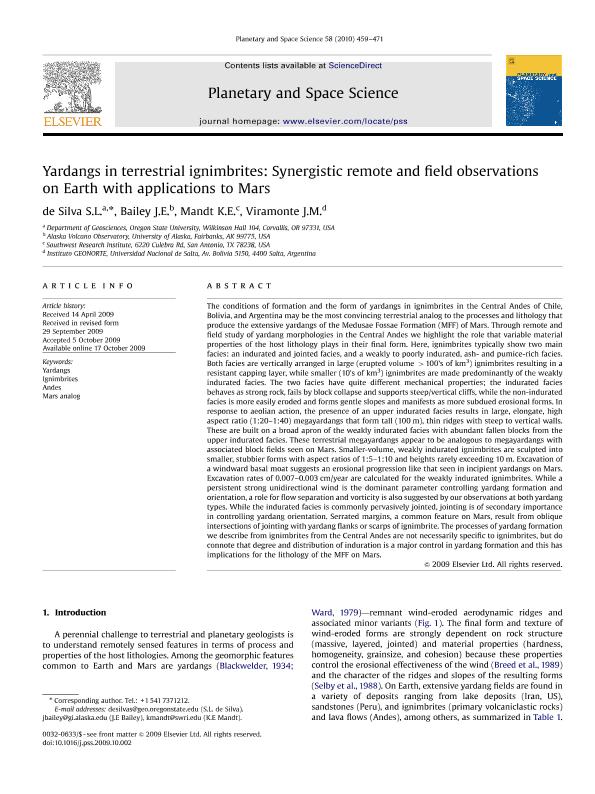Mostrar el registro sencillo del ítem
dc.contributor.author
de Silva, S. L.
dc.contributor.author
Bailey, J. E.
dc.contributor.author
Mandt, K. E.
dc.contributor.author
Viramonte, Jose German

dc.date.available
2017-03-30T19:07:06Z
dc.date.issued
2010-03
dc.identifier.citation
de Silva, S. L.; Bailey, J. E.; Mandt, K. E.; Viramonte, Jose German; Yardangs in terrestrial ignimbrites: synergistic remote and field observations on Earth with applications to Mars; Elsevier; Planetary And Space Science; 58; 4; 3-2010; 459-471
dc.identifier.issn
0032-0633
dc.identifier.uri
http://hdl.handle.net/11336/14545
dc.description.abstract
The conditions of formation and the form of yardangs in ignimbrites in the Central Andes of Chile, Bolivia, and Argentina may be the most convincing terrestrial analog to the processes and lithology that produce the extensive yardangs of the Medusae Fossae Formation (MFF) of Mars. Through remote and field study of yardang morphologies in the Central Andes we highlight the role that variable material properties of the host lithology plays in their final form. Here, ignimbrites typically show two main facies: an indurated and jointed facies, and a weakly to poorly indurated, ash- and pumice-rich facies. Both facies are vertically arranged in large (erupted volume >100's of km3) ignimbrites resulting in a resistant capping layer, while smaller (10's of km3) ignimbrites are made predominantly of the weakly indurated facies. The two facies have quite different mechanical properties; the indurated facies behaves as strong rock, fails by block collapse and supports steep/vertical cliffs, while the non-indurated facies is more easily eroded and forms gentle slopes and manifests as more subdued erosional forms. In response to aeolian action, the presence of an upper indurated facies results in large, elongate, high aspect ratio (1:20–1:40) megayardangs that form tall (100 m), thin ridges with steep to vertical walls. These are built on a broad apron of the weakly indurated facies with abundant fallen blocks from the upper indurated facies. These terrestrial megayardangs appear to be analogous to megayardangs with associated block fields seen on Mars. Smaller-volume, weakly indurated ignimbrites are sculpted into smaller, stubbier forms with aspect ratios of 1:5–1:10 and heights rarely exceeding 10 m. Excavation of a windward basal moat suggests an erosional progression like that seen in incipient yardangs on Mars. Excavation rates of 0.007–0.003 cm/year are calculated for the weakly indurated ignimbrites. While a persistent strong unidirectional wind is the dominant parameter controlling yardang formation and orientation, a role for flow separation and vorticity is also suggested by our observations at both yardang types. While the indurated facies is commonly pervasively jointed, jointing is of secondary importance in controlling yardang orientation. Serrated margins, a common feature on Mars, result from oblique intersections of jointing with yardang flanks or scarps of ignimbrite. The processes of yardang formation we describe from ignimbrites from the Central Andes are not necessarily specific to ignimbrites, but do connote that degree and distribution of induration is a major control in yardang formation and this has implications for the lithology of the MFF on Mars.
dc.format
application/pdf
dc.language.iso
eng
dc.publisher
Elsevier

dc.rights
info:eu-repo/semantics/openAccess
dc.rights.uri
https://creativecommons.org/licenses/by-nc-nd/2.5/ar/
dc.subject
Yardangs
dc.subject
Ignimbrites
dc.subject
Central Andes
dc.subject
Mars Comparation
dc.subject.classification
Otras Ciencias de la Tierra y relacionadas con el Medio Ambiente

dc.subject.classification
Ciencias de la Tierra y relacionadas con el Medio Ambiente

dc.subject.classification
CIENCIAS NATURALES Y EXACTAS

dc.title
Yardangs in terrestrial ignimbrites: synergistic remote and field observations on Earth with applications to Mars
dc.type
info:eu-repo/semantics/article
dc.type
info:ar-repo/semantics/artículo
dc.type
info:eu-repo/semantics/publishedVersion
dc.date.updated
2017-03-29T14:46:03Z
dc.journal.volume
58
dc.journal.number
4
dc.journal.pagination
459-471
dc.journal.pais
Países Bajos

dc.journal.ciudad
Amsterdam
dc.description.fil
Fil: de Silva, S. L.. State University of Oregon; Estados Unidos
dc.description.fil
Fil: Bailey, J. E.. University Of Alaska; Estados Unidos
dc.description.fil
Fil: Mandt, K. E.. Southwest Research Institute; Estados Unidos
dc.description.fil
Fil: Viramonte, Jose German. Consejo Nacional de Investigaciones Científicas y Técnicas. Centro Científico Tecnológico Salta. Instituto de Investigaciones en Energía no Convencional; Argentina. Universidad Nacional de Salta. Facultad de Ciencias Naturales. Instituto Geonorte; Argentina
dc.journal.title
Planetary And Space Science

dc.relation.alternativeid
info:eu-repo/semantics/altIdentifier/doi/http://dx.doi.org/10.1016/j.pss.2009.10.002
dc.relation.alternativeid
info:eu-repo/semantics/altIdentifier/url/http://www.sciencedirect.com/science/article/pii/S0032063309003018
Archivos asociados
